|
Case Study
The FedEx Identity Website
An elegant solution to a complex problem
If you saw Castaway, you will remember that FedEx was cast in a
major role in that movie. But what had to happen behind the scenes
before FedEx got the part? If you know anything about corporate
identity management, you know that the producer didn't just get to
use FedEx planes and uniforms without some deep dialogs with FedEx.
The FedEx Identity site is about streamlining those sorts of
requests, and automating the process as much as possible.
FedEx gets every kind of request imaginable to use its identity. It
appears on trucks and planes, boxes and uniforms, shirts and hats,
on TV, and even at the movies. The FedEx brand touches so many
different audiences that it takes an entire department within the
corporation just to manage how that brand is used and received.

When a national catalog company started using the FedEx logo to
promote FedEx shipping to their customers FedEx needed to ensure
legitimate and correct usage of its identity. A simple, small
scale-site was created so that businesses could download approved
logo artwork and photos. The site conveyed very specific guidelines
regarding where and how the identity could be used; logo placement,
size, treatment in text, colors and more had to meet strict
standards.
The rest of the process was handled manually. The requestor would
send their catalog, movie script, web page -or whatever they were
producing - to FedEx. A FedEx employee, tasked with being the "gate
keeper," would decide whether the request should even be considered,
and, if so, who would need to approve it. They would hand carry it
to the appropriate person who would eventually return it, possibly
requiring revisions before it could be used. The gatekeeper would
then contact the requestor and communicate the required changes.
Often there were several cycles of revisions and resubmissions,
requiring approval from many parties, including the legal
department.
As demand grew the process became cumbersome. At the same time,
FedEx was expanding its business beyond express shipping to include
other shipping companies and services. With each new service
offering, the number of marks and logos grew and the task of
managing the FedEx identity grew increasingly complex. It was time
for a more sophisticated solution.
The Solution
FedEx approached Onlinefocus of Mountain View, CA to tackle the
problem. The solution was launched in 2003, and recently won the Web
Marketing Associations Best In Category award for the transportation
industry.
The new site at www.fedexidentity.com allows businesses to go online
to get approval for their usage of the identity. Not only can they
download logos, photos and usage guidelines-any documents that FedEx
needs to see, such as TV scripts or print materials can be uploaded
by the requestor and viewed online by the designated approvers. The
request is moved through a workflow customized to the type of
project in which the identity will be used. The requestor knows at
all times where their request is in the approval queue.
Diverse Users with diverse needs
Three important requirements form the basis of the redesigned
requestor interface.
1. The process must be painless - FedEx did not want to risk
non-compliance by making it cumbersome. Existing applicants, already
familiar with the approval process, want quick access to the
downloadable resources and the application form. New applicants-by
far the majority-need more instruction and "hand-holding."
Onlinefocus designed separate paths for the two user groups.
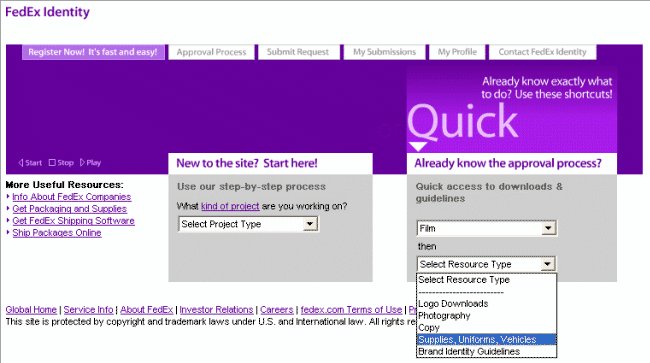
A guided 'wizard' walks first time users step-by-step through the
process of acquiring resources and requesting permission. This
ensures that they understand and complete the process with
confidence and accuracy.
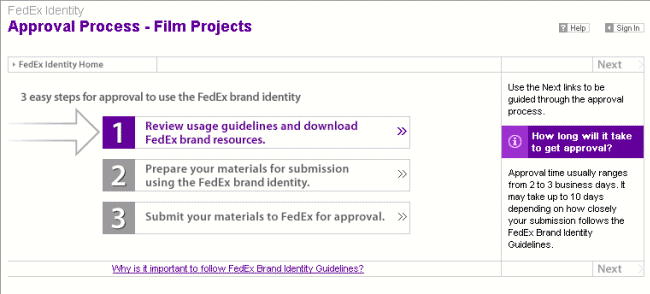
Users who already know the process, can take a short-cut directly to
the resources they need. The abbreviated workflow lets them bypass
information they don't need, such as the identity usage guidelines,
while still making the supportive information easily accessible to
review if needed.
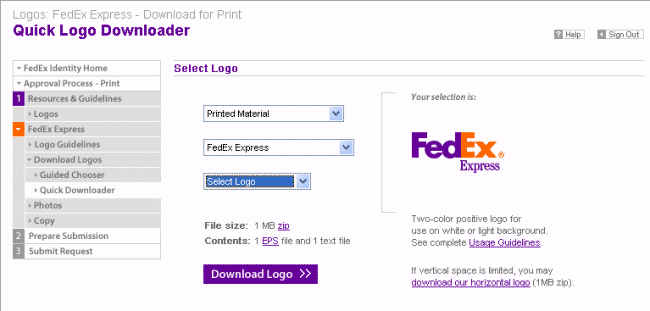
For both user groups the left hand navigation area numbers all the
steps and makes it clear which step the user is on. This orients
them to the entire process and encourages them to participate in all
the steps.
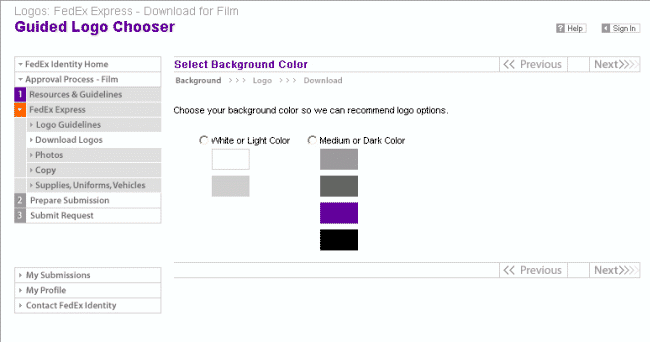
2. Because the approval process and appropriate resources
vary according to the type of project, different information and
files are made available depending upon the project type. After
users indicate whether they want access to logos, photos and copy,
they are shown only resources and guidelines relevant to the items
they need.
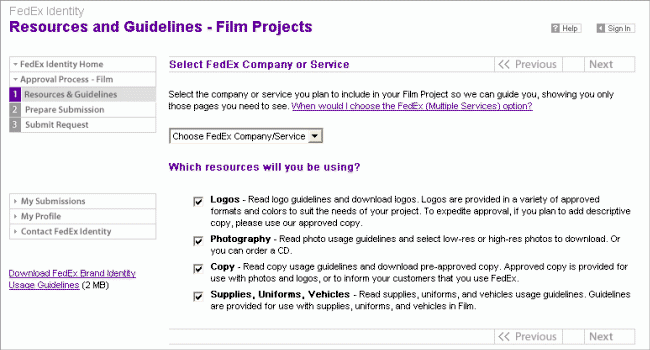
3. A separate but connected administrative web site enables
the FedEx brand management team to efficiently manage the approval
process online.
An administrative dashboard displays the most urgent information
first. On the home page, red text alerts the administrator to
requests with fast approaching deadlines that are stuck in the
approval queue. The administrator can easily see where they may need
to intervene to keep the request moving through the process.
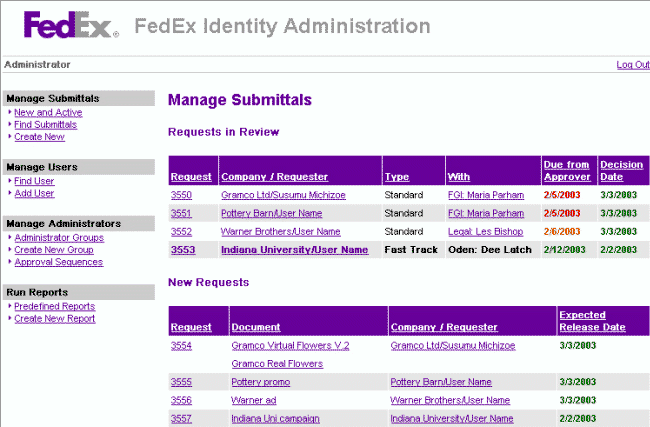
New requests are displayed in a separate table. The administrator
can click through to view the details of any new request and put it
into the approval queue if it meets certain criteria.
As the request moves through the approval workflow, applicants, the
administrator and approvers are all kept informed through a system
of automated emails. Approvers can attach comments identifying
contingencies for approval.
By transforming what was still mostly a manual process to one that
was automated, significant burden is lifted from the FedEx resources
who handle all the requests.
The system also allows FedEx to track requests through a series of
reports. The administrator can run reports based on activity during
specific time periods, project types, or type of resource download.
This way, FedEx can easily analyze usage requests. They can, for
example, determine how many requests came in for using the identity
in movies, how many logos were downloaded, or whether requests
increased during a particular marketing campaign.
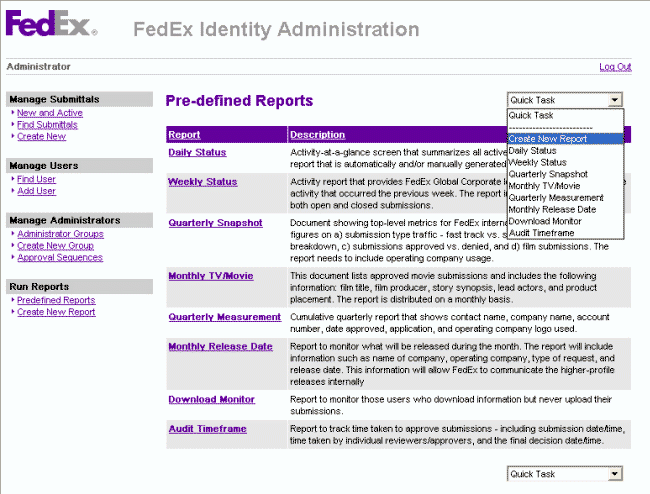
The Process
Onlinefocus applied its user-centric design philosophy to create
the site. They began the process by interviewing key stakeholders at
FedEx to ensure buy-in and establish a clear understanding of the
business goals of the project. Next they interviewed users who were
representative of the target market to gain an understanding of
their goals, needs and objectives related to using the FedEx
identity. The primary administrator was also interviewed to
understand her needs related to workflow, and content priorities.
This investigative phase identified key factors the design should
address such as the diversity of the users mentioned earlier.
Onlinefocus then began designing the information structure and
interface that could meet these requirements. Interactive mockups
were developed to test the design concept on representative users.
By testing mockups with actual users over a period of time, the
designers were able to experiment with creative solutions to the
interface challenge. User testing mitigated the risk that the
project would move into the more costly development phase based on
untested assumptions. As the design was refined and tested the
solution gelled, and the product moved into development.
FedEx reports that the approval process has been streamlined and
improved for both the applicants and the FedEx administrators.
View the site at www.fedexidentity.com. Founded in 1995, Onlinefocus
is, a
Silicon Valley based, web design, development, and creative agency,
with offices
In Mountain View, Memphis, Boca Raton, Cincinnati and Portland. (www.onlinefocus.com).(650)
605-6500
|



|



